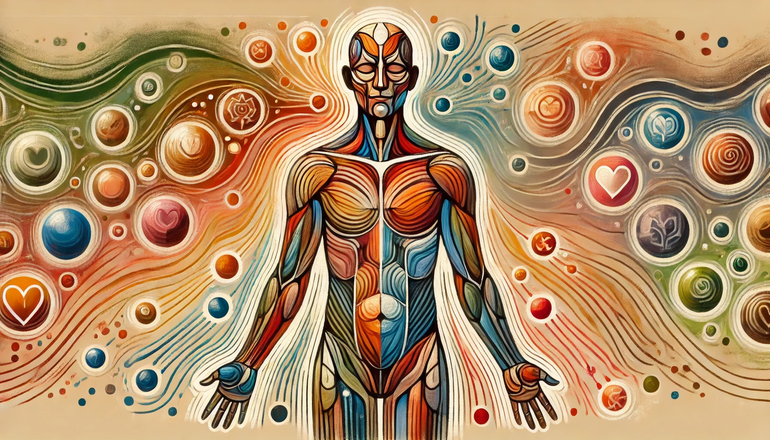Have you ever wondered how emotions affect our bodies? The emotional map of the body is a tool that helps us better understand how anger, sadness, or anxiety manifest in different parts of our bodies. Emotions in the body can cause muscle tension and sometimes lead to more complex physical reactions. Familiarizing yourself with the emotional map can help increase self-awareness, improve recognition and management of emotional states, and help in relaxing tense muscles and improving overall well-being. Read the article below to learn how we physically experience emotional reactions and how we can effectively alleviate them.
Map of Difficult Emotions in the Body – Map of Positive and Negative Emotions
Scientific research shows that different emotions tend to manifest in specific areas of the body. For example, anger is often associated with tension in the upper body, particularly in the shoulders and neck, leading to headaches and migraines. Sadness, on the other hand, often causes a feeling of heaviness in the chest, affecting our breathing and overall feeling of depression.
Emotional reactions impact long-term health. Chronic anxiety leads to digestive issues, such as irritable bowel syndrome, and general weakening of the immune system. Therefore, it is worth taking a moment to reflect on how our bodies react to different emotions.
Practices such as meditation, tratak meditation, deep breathing, regular tantric massages, and regular physical exercise help in relaxing tense muscles and improving overall well-being. By understanding the emotional map of the body, you can better comprehend your emotional reactions and work on alleviating them. This way, you will make your life healthier and more balanced.
Map of Your Emotions in the Body – How to Identify Them?
Modern psychology increasingly focuses on how our emotions affect our body's physiology. As psychologist Dr. Kaja Tomczyk (SWPS, 2023) points out, our bodies provide signals that help us better understand our emotional states.
Emotions such as frustration, guilt, or hurt have physical manifestations. Research shows that we experience different emotions in varied ways in our bodies. For instance, an accelerated heartbeat might signal fear or excitement, while a tightness in the chest might indicate sadness or anxiety.
A map of difficult emotions in the body helps you better understand yourself and your mental states. To create one, start by noticing where you feel specific emotions in your body. For example:
- Frustration – often felt as muscle tension in the shoulders and neck.
- Guilt – may manifest as a tightness in the stomach.
- Fear – usually associated with an accelerated heartbeat and chest tension.
When you begin to notice these emotions, the blockages in your body will start to ease. An emotional map will help you better understand yourself, giving you a sense of being "more in tune" with yourself.
How to Reawaken the Feeling of Emotions?
To find emotions that are frozen in your body, it's helpful to focus on regularly observing your body in various emotional situations. You can do this through:
- Mindful Breathing – Pay attention to your breath. Is it shallow, fast, deep? Notice what emotions accompany different breathing patterns.
- Muscle Relaxation – Perform relaxation exercises daily to help you notice muscle tension. This can include massage, yoga, or simple stretching exercises.
- Mindfulness Exercises – Practices such as meditation will help you notice subtle signals in your body that may indicate the presence of frozen emotions.
- Keeping an Emotion Journal – Writing down your emotions and the physical sensations associated with them will help you better understand how different emotions affect your body.
- Psychological Therapy – During therapy sessions, you can work with a therapist to recognize and release emotions frozen in your body. Therapy will help you better understand the mechanisms of blocking emotions and learn how to express them. Trauma therapy may sometimes be necessary.
When and How Can Emotions Affect Our Bodies?
Strong emotions, such as stress, anxiety, or joy, can cause changes in the functioning of the nervous, hormonal, and cardiovascular systems. For example, stress can lead to an accelerated heartbeat, increased blood pressure, and muscle tension. Prolonged stress or unpleasant emotions weaken the immune system, making the body more susceptible to illness. Conversely, positive emotions support the functioning of the immune system.
Emotions affect our habits and behaviors, such as eating, sleeping, and physical activity. For instance, people experiencing sadness may suffer from sleep disturbances or change their eating habits. Negative emotions, like anger or frustration, manifest in the body as headaches, digestive problems, or muscle tension. Additionally, emotions influence hormone secretion, which directly impacts various physiological processes. Therefore, recognizing your emotions is so important! It is not worth suppressing them because they are our guides, releasing great amounts of energy. It is beneficial to find and understand them to learn how to manage them, as every emotion is important.
Sources:
Kabat-Zinn, J. (2013). Full Catastrophe Living: Using the Wisdom of Your Body and Mind to Face Stress, Pain, and Illness. New York: Bantam Books.
Nummenmaa, L., Glerean, E., Hari, R., & Hietanen, J. K. (2014). Bodily maps of emotions. Proceedings of the National Academy of Sciences, 111(2), 646-651.
Porges, S. W. (2024). Polyvagal Theory: Neurophysiological Foundations of Emotions, Attachment, Communication, and Self-Regulation. SWPS University.
Tomczyk, K. (2023). The Body Keeps the Score: How Emotions Are Stored in Our Bodies and How to Release Them. Podcast Episode.
Field, T. (2020). Massage therapy research review. Complementary Therapies in Clinical Practice, 39, 101071. https://doi.org/10.1016/j.ctcp.2020.101071
Grossman, P., Niemann, L., Schmidt, S., & Walach, H. (2010). Mindfulness-based stress reduction and health benefits: A meta-analysis. Journal of Psychosomatic Research, 57(1), 35-43. https://doi.org/10.1016/j.jpsychores.2003.09.005
















Leave a comment